|
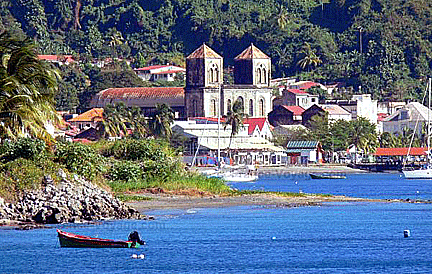 For the past hour, Leon Compere had been
repairing shoes in his home workshop in Saint Pierre, Martinique. Sylbaris,
a black man serving time in the town prison for assault and battery, was
just finishing his meager breakfast. Neither man could have known that
within minutes their lives were about to change forever. It was 7:45
A.M. on
Thursday, May 8, 1902. For the past hour, Leon Compere had been
repairing shoes in his home workshop in Saint Pierre, Martinique. Sylbaris,
a black man serving time in the town prison for assault and battery, was
just finishing his meager breakfast. Neither man could have known that
within minutes their lives were about to change forever. It was 7:45
A.M. on
Thursday, May 8, 1902.
Saint Pierre, known as the "Paris of the West Indies," lay clean and
pristine after an overnight thunderstorm. It was all stone-built and
stone-paved, with narrow streets, wooden or zinc awnings, and peaked roofs
of red tile, pierced by gabled dormers. Most of the buildings, painted
in a clear yellow tone, contrasted with the burning blue ribbon of the
tropical sky. No street ran absolutely level. Nearly all of them climbed the
hills, descended into hollows, curved and twisted in sudden angles.
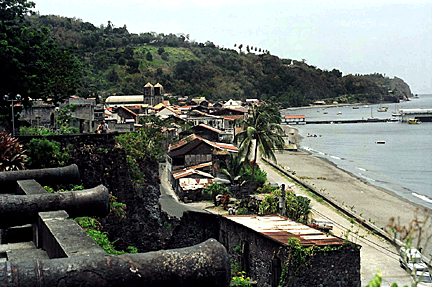 Everywhere
the loud murmur of running water filled the air, pouring through deep
gutters contrived between the paved thoroughfares and the absurd little
sidewalks, varying in width from one to three feet. The architecture
appeared quite old, 17th-century probably, reminding visitors of New Orleans' French
Quarter. The windows were frameless openings without glass, some with iron
bars, all with heavy green or bluish-gray wooden shutters with moveable
slats, through which light and air could enter. Almost every house had a
freshwater fountain inside. Everywhere
the loud murmur of running water filled the air, pouring through deep
gutters contrived between the paved thoroughfares and the absurd little
sidewalks, varying in width from one to three feet. The architecture
appeared quite old, 17th-century probably, reminding visitors of New Orleans' French
Quarter. The windows were frameless openings without glass, some with iron
bars, all with heavy green or bluish-gray wooden shutters with moveable
slats, through which light and air could enter. Almost every house had a
freshwater fountain inside.
The town covered about 30 acres, with 2,985 houses on 103 streets, squares
and lanes with a length of about 12 miles. Built along a sandy beach rising
in tiers on gently sloping ground, St. Pierre consisted
of two districts by the Roxelane River.
In the center of town stood a large paved square, Place Bertin,
on one side of
which stood a tower, the Semaphore, and a continuously flowing fountain. On
the opposite side stood the galleried Chamber of Commerce with a clock on
the front. Nearby stood the archbishop's residence and cathedral, as almost
all of the residents were Catholic.
Saint Pierre boasted several banks, six consulates, three newspapers, four
printing offices, a score of distilleries, a foundry, ten butchers, fifteen
bakers, and a hundred food dealers, plus a myriad of shops and warehouses
along the waterfront.

Residents, known as Pierrotins, enjoyed promenading in the Jardin de Plantes,
a botanical garden created at the beginning of the 19th century, located at
the farthest end of town. But St. Pierre's most beautiful ornament
had to be its theater,
built a few years before the French Revolution.
At the beginning of the 20th century, Saint Pierre was, by far, the most
modern town in the Antilles, equipped with electricity, two transatlantic
cables, the telephone, plus a tramway connecting its center to its western
suburb.
Such was Saint Pierre when the volcano, Mount Pelee, awoke.
Mount Pelee first erupted in 1792. Half a century went by. In August, 1851,
the volcano manifested itself once again.
The blast covered Saint Pierre in ashes, the
countryside strewn with dead birds choked by the sulphurous vapors. Half a
century later, the mountain awoke yet again.
Warnings began in February of 1902, with the strong smell of sulphur and
dead birds. During the last week of April, activity increased.
 On Saturday, May 3, the crater vomited flames and hurled large stones as far
as one and a half miles away. Again, the volcano covered
Saint Pierre with ashes— grey ashes
as fine as sawdust that crept in everywhere. The people crowded the
cathedral in the afternoon
seeking absolution. On Saturday, May 3, the crater vomited flames and hurled large stones as far
as one and a half miles away. Again, the volcano covered
Saint Pierre with ashes— grey ashes
as fine as sawdust that crept in everywhere. The people crowded the
cathedral in the afternoon
seeking absolution.
For the next four days ashes continued to fall. By Wednesday afternoon panic
began to spread among the population. No one in Saint Pierre slept much that
night. Ceaseless denotations and odd noises kept everyone awake. Rain poured
down while columns of dark smoke streaked with tongues of flames broke forth
from the crater. Muffled and sinister rumbles coming out of the mountain
spread terror among the population.
About 4:00 A.M. a lull came. Some people, exhausted, their nerves frayed,
threw themselves on their beds to get some rest, while others were
feverishly gathering their most precious belongings, getting ready to depart
from the town. A crowd was already trying to storm its way to the harbor and
the boats.
Even at this early hour, the streets were busy. Passers-by called to one
another. Some had put on the first clothes they found, others dressed in
their Sunday best, their missel and beads in hand, going to church hoping,
on this Ascension Day, to calm down Nature’s Divine Wrath by their prayers.
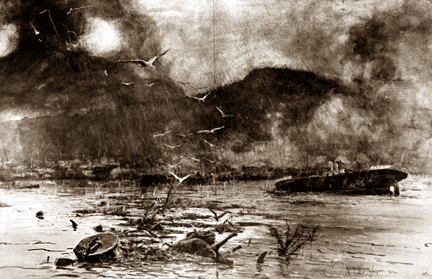 At 7:45 A.M., the Angelus bell rang. In fact, it was tolling. And God only
knew that the last minutes of the town were now spilling away. At 7:45 A.M., the Angelus bell rang. In fact, it was tolling. And God only
knew that the last minutes of the town were now spilling away.
Sensing impending doom, Leon Compere gathered up what few belongings he
could carry and ran down the road toward Saint-Denis.
Suddenly, the mountain split from top to base to let go a blazing
flame-filled thick black cloud streaked with lightening. With a great roar,
it rushed down the mountainsides at tremendous speed and threw itself upon
the town, covered and smothered it and set it ablaze. It reached the sea in
less than two minutes, playing havoc in its passage. Nothing could resist
this blazing whirl of over 3,500 degrees F. A shower of small stones fell
upon the town along with a rain of slimy blackish mud and burning ashes.
Those not directly hit by the blazing avalanche, hot ashes and the boiling
vapors of the cloud burned many people. At 7:50 A.M., life stopped in Saint
Pierre.
The volcano vomited for nearly two hours, until seemingly breathless, it
calmed down.
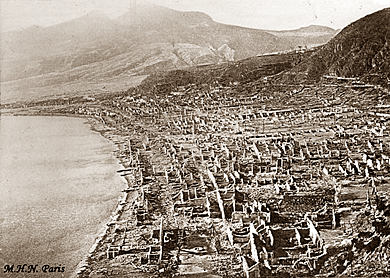 As the atmosphere cleared, the curtain rose on a horrific sight. A
35-square-mile area had been reduced to absolute nothingness. The town was
completely set ablaze. Explosions, caused by the barrels and boilers of the
distilleries exploding like machine-gun shots, simultaneously burst out in
different parts of town. As the atmosphere cleared, the curtain rose on a horrific sight. A
35-square-mile area had been reduced to absolute nothingness. The town was
completely set ablaze. Explosions, caused by the barrels and boilers of the
distilleries exploding like machine-gun shots, simultaneously burst out in
different parts of town.
Not a breath of life came from Saint Pierre. Desolation and ruins were
everywhere. Tumbled down stone buildings, burned out wooden houses, sagged
roofs, a few dilapidated walls rising toward the sky. Pulled down, leafless
trees blocked and littered the streets. Columns of smoke rose here and
there. As if a monument to the destruction, a piece of wall of the Military
Hospital still stood, the hands of its clock stuck upon the Hour of Death.
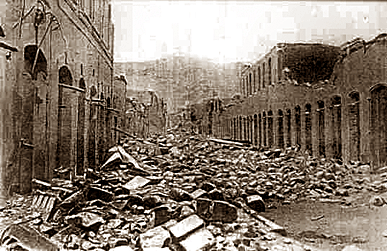 The air reeked with putrid smells mixed with the acrid smell of burned
flesh. Blackened and stiffened corpses were everywhere. Here the carrion of
an animal, there the shriveled remains of a human body with an arm lifted up
above its head in a pitiful and vain gesture of defense. There again, a
skeleton. As the wind stirred, it crumbled to dust. Once, it was a man. The air reeked with putrid smells mixed with the acrid smell of burned
flesh. Blackened and stiffened corpses were everywhere. Here the carrion of
an animal, there the shriveled remains of a human body with an arm lifted up
above its head in a pitiful and vain gesture of defense. There again, a
skeleton. As the wind stirred, it crumbled to dust. Once, it was a man.
Saint Pierre became a vast crematorium for its 30,000 unfortunate souls.
Included among the dead were the American consul, Thomas Prentiss and his
wife, Clara.
The government in Fort de France, Martinique’s capital, sent in a search
party. They shouted again and again, but no one answered. Three days later,
several people wandering the streets heard a kind of low moaning at the end
of Victor Hugo Street. It came from where the theater once stood.
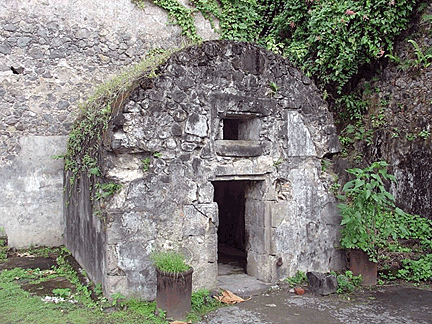 At last, after much digging through debris, they succeeded in locating the
sound. It came from the dark underground cell of the prison. There huddled
Sylbaris, shaking all over. At last, after much digging through debris, they succeeded in locating the
sound. It came from the dark underground cell of the prison. There huddled
Sylbaris, shaking all over.
"It was about eight... suddenly, a tremendous noise burst out," he said.
"Everyone called for help, crying out, 'I am burning, I am dying.' Five
minutes later, there were no more cries, except mine."
Another firey blast, at least as violent as the first, occurred on May 20,
leveling what remained of the buildings in Saint Pierre.
The people of Martinique never accepted that the old city should lie
deserted. The town once again rose from its ruins, although not the
flourishing place it once was.
Leon Compere returned to his house, protected from destruction by a hill, to
continue repairing shoes. Sylbaris later joined P.T. Barnum's circus to show
his face and body covered with scars resulting from his numerous burns.
* * * * * * * * * * * *
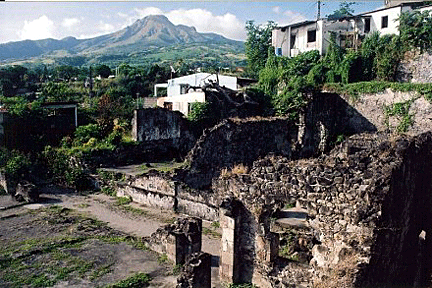 I couldn't help feeling sad and somewhat emotional as I walked along the
streets, many still paved with the old paving. Here and there, I could see
the remains of some stones and buildings. I couldn't help feeling sad and somewhat emotional as I walked along the
streets, many still paved with the old paving. Here and there, I could see
the remains of some stones and buildings.
Today, Saint Pierre is a sleepy town of 6,000—with a big history. Broken
statues toppled from villa gardens lie in silent testimony. Boulevards
eerily vanish beneath a tangle of tropical growth.
The most touching ruin in Saint Pierre is the cathedral, with remains of its
altar once adorned with marble statues, the place where the bell tower
stood, and the pediment, thrust several yards ahead by the blazing cloud.
But the most interesting ruin is that of the Health Colonial House, on the
north side of town. A old lunatic asylum, it features cells and iron seats
provided with a bar to hold down the raving lunatics.
 Frank Alvard Perret, an American vulcanologist,
was also touched by Saint Pierre. In 1933, he founded the Vulcanology
Museum. It stands on the site of the old Esnotz Battery which defended the
harbor. A flight of stairs to the former Chemin de Ronde or watchtower, a
favorite promenade for town dwellers, still exists. It also contains the
remains of a private house, a fountain with a jet of water and a grotto. Frank Alvard Perret, an American vulcanologist,
was also touched by Saint Pierre. In 1933, he founded the Vulcanology
Museum. It stands on the site of the old Esnotz Battery which defended the
harbor. A flight of stairs to the former Chemin de Ronde or watchtower, a
favorite promenade for town dwellers, still exists. It also contains the
remains of a private house, a fountain with a jet of water and a grotto.
Restored and modernized in 1969, the museum contains a great number of
engravings, photos, maps and documents evoking the everyday life of Saint
Pierre before the eruption, as well as an important collection of relics,
including fused coins, a charred sewing machine, and a melted bottle with
perfume still inside.
It tells the story of the last days of Saint Pierre in vivid
displays—twisted and tortured clocks that stopped at the hour the volcano
erupted--as well as before and after photographs that are hard to believe in
comparison to the sleepy village that has taken the place of this
once-thriving city.
Below it lie the ruins of shops and warehouses, with rolls of barbed wire
agglomerated under the action of the heat emitted by the burning clouds. A
testament to the power of Nature.
< Back to
History Articles
Go to next History article > |
